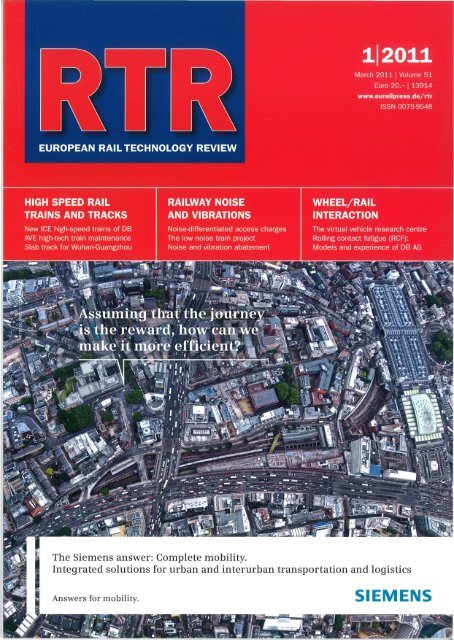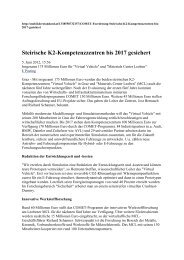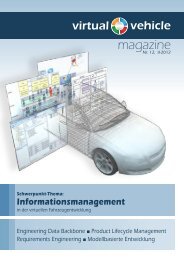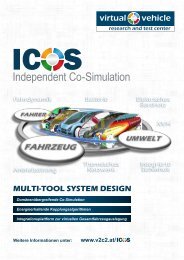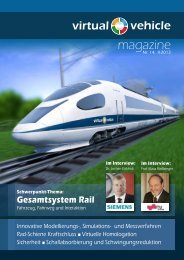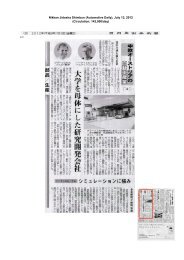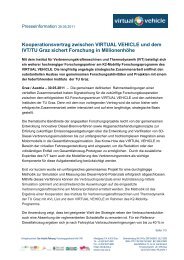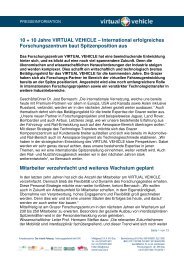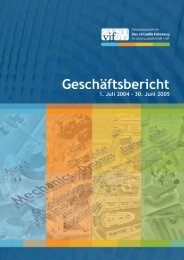The Siemens answer: Complete mobility. - Virtual Vehicle
The Siemens answer: Complete mobility. - Virtual Vehicle
The Siemens answer: Complete mobility. - Virtual Vehicle
You also want an ePaper? Increase the reach of your titles
YUMPU automatically turns print PDFs into web optimized ePapers that Google loves.
<strong>The</strong> <strong>Siemens</strong> <strong>answer</strong>: <strong>Complete</strong> <strong>mobility</strong>.<br />
Integrated solutions for urban and interurban transportation and logistics<br />
Answers für mübility. SIEMENS
Front cover:<br />
<strong>Complete</strong> <strong>mobility</strong>.<br />
Ensuring <strong>mobility</strong> is the number-one challenge in our<br />
society. We need networked traffic and information<br />
systems to remain mobile in future - for safe, costeffective<br />
and environmentally friendly passenger and<br />
cargo traffic. That is why, with "<strong>Complete</strong> <strong>mobility</strong>",<br />
<strong>Siemens</strong> creates integrated efficient transport and<br />
logistics solutions, from infrastructure equipment for<br />
rail and road traffic, rail vehicles through to airport<br />
logistics and postal automation. (Foto: <strong>Siemens</strong>)<br />
Superior quality, reliability, and a long life span - these are<br />
the high standards you can expect from ZF's cutting-edge<br />
technology for all types of rall vehicle: the optimized weight<br />
of the ZF-Highspeed transmission, complete driveline<br />
systems, damping components and modules, and vibration<br />
isolation for greater comfort and safety.<br />
Driveline and Chassis Technology
Research into vehiclejtrack interactions<br />
Knowledge of the interactions between rai/way vehicles and their track is a<br />
precondition for further optimisation of the wheeljrail system. <strong>The</strong> "<strong>Vehicle</strong><br />
Oynamics - Rail Applications" group within in the <strong>Virtual</strong> <strong>Vehicle</strong> Research Centre<br />
in Graz (Austria) is involved in a project to establish the influences of various<br />
parameters on the dynamic interactions between vehicles and railway tracks and<br />
their consequential effects, making use of vehicles, which, although only virtual,<br />
are very close to reality.<br />
Rg. 1: Computer graphie ofa "virtual rai/way vehiele"<br />
Sourees: <strong>Siemens</strong> (photo) and <strong>Virtual</strong> Vehiele (multiple-body simulation. graphie)<br />
<strong>The</strong> decisive factor in optimising the railway<br />
as a system is to apply a holistic, systematic<br />
view of that system, along with the subsystems<br />
"vehicle" and "track", and the way<br />
they interact through the wheeljrail contact.<br />
<strong>The</strong> kernel of the wheeljrail contact can be<br />
studied by looking into four facets: "contact<br />
geometry", "adhesion", "wear" and "damage".<br />
In addition to this, the structural dynamic<br />
properties of the wheel sets as weil<br />
as the dynamic properties of the track are<br />
of importance. Allofthis is also associated<br />
with questions regarding the quality of the<br />
track's geometry and the condition of the<br />
track.<br />
By fitting together the specific simulation<br />
Dipl.-Ing.<br />
Bernd Luber<br />
Team Leader <br />
Rail Applications<br />
Area Mechanics<br />
<strong>Virtual</strong> <strong>Vehicle</strong> Competence Centre, Graz<br />
bemd.luber@V2c2.at<br />
32 RTR 1/2011<br />
models in the area of "rail systems", as<br />
the Graz centre is doing, it becomes possible<br />
to produce conclusions closely reflecting<br />
the reality of the railway as a complete<br />
system. <strong>The</strong>se results can then be applied<br />
right fram the early phase of product development<br />
thraugh to maintenance (Fig. 1).<br />
1 Wheeljrail contact<br />
Effects occur at the point of adhesion between<br />
the wheel and the rail that are relevant<br />
not only for the dynamics of vehicle<br />
movement and the track andjor the damage<br />
phenomena but also for making adjust-<br />
Dr. techno<br />
Martin Rosenberger<br />
Co-Head of<br />
Area Mechanics<br />
<strong>Virtual</strong> <strong>Vehicle</strong> Competence Centre, Graz<br />
martin.rosenberger@v2c2.at<br />
ments to traction and braking. <strong>The</strong> "rail systems"<br />
group in Graz is developing models<br />
for the purpose of recording relevant influences<br />
and visualising them reliably.<br />
It is a fair general statement that the mechanisms<br />
regarded as responsible for the occurrence<br />
of many of the forms of damage<br />
affecting wheels and rails have not yet been<br />
adequately researched. It is possible that<br />
a better understanding of the processes at<br />
play in wheeljrail contact may lead to a reduction<br />
in wear and rolling contact fatigue<br />
(RCF) affecting both wheels and rails. If so,<br />
it will then be possible to lengthen maintenance<br />
intervals and bring down maintenance<br />
costs. At the same time, there will<br />
be improvements in operational safety and<br />
passenger comfort.<br />
1.1 Damage mechanisms<br />
In order to understand the underlying<br />
mechanisms that lead to wear (profile wear,<br />
short-pitched rail corrugations and eccentricities)<br />
and RCF (head checks and herringbone<br />
patterns), it is necessary to know<br />
about the friction processes occurring at<br />
the point of contact, on the one hand, and<br />
the structural dynamics of the vehicle and<br />
the track, on the other hand (Fig. 2).<br />
<strong>The</strong> effects occurring at the point of adhesion<br />
between wheels and rails are, however,<br />
also of significance for adjusting traction<br />
and breaking. <strong>The</strong> models already in<br />
use today do not take sufficient account<br />
of them. <strong>The</strong> adhesion characteristics are<br />
affected by temperature influences, rough-<br />
Dr. techno<br />
Michael Schmeja<br />
Area Manager System<br />
..,o;:",.lYI'•• Design & Optimisation<br />
Head of Interdepartmental<br />
Function RAIL<br />
<strong>Virtual</strong> <strong>Vehicle</strong> Competence Centre, Graz<br />
Michael.Schmeja@V2c2.at


